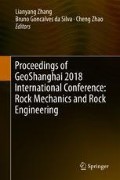Abstract
In an enhanced geothermal system (EGS), fluid is injected into pre-existing fractures to be heated up and then pumped out for the electricity generation; injected fluid is cold as compared to surrounding bedrock. The rock-fluid temperature difference induces thermal stress along the fracture wall, and the large thermal stress could damage some of the self-propping asperities and result in a change of the topography and lifespan of the fractures. Although fracture sustainability has been extensively studied, the mechanism of asperity damage due to rock-fluid temperature difference remains unknown. We have constructed a finite-element based three-dimensional model, which uses a hemisphere contact pair to resemble a single self-propping asperity, to investigate the effect of temperature difference on the asperity damage. In the model, the rock mechanical properties are coupled with temperature and stress state of the bedrock. Two trends of asperity deformation with temperature effect are identified: opening zone and closure zone. Closure squeezes asperity further and induces more element damage at bottom. Higher temperature difference damages elements on asperity top whereas has negligible impact on elements at asperity bottom. In other aspect, a higher temperature expands closure zone and degrades elements at the asperity bottom. Accordingly, two potential mechanisms of asperity damage are qualitatively characterized.
Access this chapter
Tax calculation will be finalised at checkout
Purchases are for personal use only
References
Tester, J.W., Anderson, B.J., Batchelor, A.S., Blackwell, D.D., DiPippo, R., Drake, E., Garnish, J., Livesay, B., Moore, M.C., Nichols, K., Petty, S.: The future of geothermal energy. In: impact of enhanced geothermal systems (EGS) on the United States in the 21st Century, p. 372. Massachusetts Institute of Technology, Cambridge, MA (2006)
Bertani, R.: Geothermal power generation in the work 2010–2014 update report. Geothermics 60, 31–43 (2016)
Guo, B., Fu, P., Hao, Y., Peters, C.A., Carrigan, C.R.: Thermal drawdown-induced flow channeling in a single fracture in EGS. Geothermics 61, 46–62 (2016)
Luo, S., Zhao, Z., Peng, H., Pu, H.: The role of fracture surface roughness in macroscopic fluid flow and heat transfer in fractured rocks. Int. J. Rock Mech. Min. Sci. 87, 29–38 (2016)
Pandey, S.N., Chaudhuri, A., Kelkar, S.: A coupled thermo-hydro-mechanical modeling of fracture aperture alteration and reservoir deformation during heat extraction from a geothermal reservoir. Geothermics 65, 17–31 (2017)
Bruel, D.: Impact of induced thermal stresses during circulation tests in an engineered fractured geothermal reservoir: example of the Soultz-sous-Forets European hot fractured rock geothermal project, Rhine Graben, France. Oil Gas Sci. Technol. 57(5), 459–470 (2002)
Tarasovs, S., Ghassemi, A.: Propagation of a system of cracks under thermal stress. In: 45th US Rock Mechanics/Geomechanics Symposium. American Rock Mechanics Association (2011)
Finnie, I., Cooper, G.A., Berlie, J.: Fracture propagation in rock by transient cooling. Int. J. Rock Mech. Min. Sci. Geomech. Abs. 16(1) (1979)
Murphy, H.D.: Thermal Stress Cracking and the Enhancement of Heat Extraction From Fractured Geothermal Reservoirs. No. LA-7235-MS. Los Alamos Scientific Lab., N. Mex.(USA) (1978)
Barr, D.T.: Thermal Cracking in Nonporous Geothermal Reservoirs. Diss. Massachusetts Institute of Technology (1980)
Grasselli, G.: Shear Strength of Rock Joints Based on Quantified Surface Description (2001)
Ghassemi, A., Kumar, G.S.: Changes in fracture aperture and fluid pressure due to thermal stress and silica dissolution/precipitation induced by heat extraction from subsurface rocks. Geothermics 36(2), 115–140 (2007)
Sadd, M.H.: Elasticity: Theory, Applications, and Numerics. Academic Press, Boston (2009)
Ashby, M.F., Sammis, C.G.: The damage mechanics of brittle solids in compression. Pure. appl. Geophys. 133(3), 489–521 (1990)
Lockner, D.: The role of acoustic emission in the study of rock fracture. Int. J. Rock Mech. Min. Sci. Geomech. Abs. 30(7) (1993)
Tang, C.A., Liu, H., Lee, P.K.K., Tsui, Y., Tham, L.G.: Numerical studies of the influence of microstructure on rock failure in uniaxial compression—part I: effect of heterogeneity. Int. J. Rock Mech. Min. Sci. 37(4), 555–569 (2000)
Lemaitre, J.: A continuous damage mechanics model for ductile fracture. Transactions of the ASME. J. Eng. Mater. Technol. 107(1), 83–89 (1985)
Okubo, S., Fukui, K.: Complete stress-strain curves for various rock types in uniaxial tension. Int. J. Rock Mech. Min. Sci. Geomech. Abs. 33(6) (1996)
Hawkes, I., Malcolm, M., Stephen, G.: Deformation of rocks under uniaxial tension. Int. J. Rock Mech. Min. Sci. Geomech. Abs. 10(6) (1973)
Schock, R.N., Louis, H.: Strain behavior of a granite and a graywacke sandstone in tension. J. Geophys. Res. Solid Earth 87(B9), 7817–7823 (1982)
Tapponnier, P., Brace, W.F.: Development of stress-induced microcracks in Westerly granite. Int. J. Rock Mech. Min. Sci. Geomech. Abs. 13(4) (1976)
Lajtai, E.Z., Bielus, L.P.: Stress corrosion cracking of Lac du Bonnet granite in tension and compression. Rock Mech. Rock Eng. 19(2), 71–87 (1986)
Jaeger, J.C., Cook, N.G., Zimmerman, R.: Fundamentals of Rock Mechanics. Wiley, New York (2009)
Santucci, S., Grob, M., Toussaint, R., Schmittbuhl, J., Hansen, A., Maløy, K.J.: Fracture roughness scaling: A case study on planar cracks. EPL (Europhysics Letters) 92(4), 44001 (2010)
Author information
Authors and Affiliations
Corresponding author
Editor information
Editors and Affiliations
Rights and permissions
Copyright information
© 2018 Springer Nature Singapore Pte Ltd.
About this paper
Cite this paper
Zeng, C., Deng, W., Wu, C., Insall, M. (2018). Thermal Stress Effect on Fracture Integrity in Enhanced Geothermal Systems. In: Zhang, L., Goncalves da Silva, B., Zhao, C. (eds) Proceedings of GeoShanghai 2018 International Conference: Rock Mechanics and Rock Engineering. GSIC 2018. Springer, Singapore. https://doi.org/10.1007/978-981-13-0113-1_41
Download citation
DOI: https://doi.org/10.1007/978-981-13-0113-1_41
Published:
Publisher Name: Springer, Singapore
Print ISBN: 978-981-13-0112-4
Online ISBN: 978-981-13-0113-1
eBook Packages: Earth and Environmental ScienceEarth and Environmental Science (R0)

